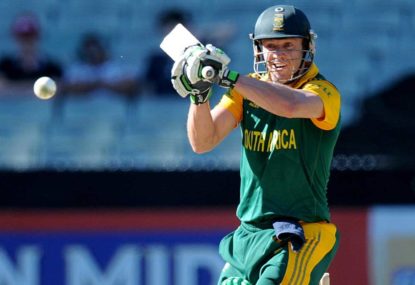AB de Villiers, with his shuffle and shimmy routine, is the fastest to 50, 100 and 150 ODI runs. But some are jumping to conclusions about his place in cricket history.
AB is one of the most imaginative, most innovative short-form operators. But some are nailing plaques on the ODI Wall of Fame based on what ‘he would’, ‘he could’ have done had he faced stronger, wider resistance.
Cricket writers scramble to capture the ‘fastest this’ and the ‘fastest that’ of new-era batsmen. Hashim Amla, for instance, is the fastest to 5,000 ODI runs.
And Virat Kohli draws comparisons with Sachin Tendulkar.
Roughly 78 per cent of the cricketing fraternity whines against comparison. The other 78 per cent joyfully compares. The problem isn’t so much with comparison, as with context.
Of course there’s a lot of hammering of cricket balls going on. But what’s the context? Where’s the ferocity of the bowling challenge – the most decisive check on a ‘speeding’ batsman?
Where, amidst these speed-fests, are the most tested, most proven, most consistent ODI bowlers? Nowhere, it seems.
Among two dozen proven bowlers (at least 250 wickets) only four are still bowling – Shahid Afridi, Dan Vettori, Lasith Malinga and Jimmy Anderson.
Among the 20 most tested bowlers (at least 10,000 balls) only two remain – Afridi and Vettori.
Among 11 with at least five ‘five wickets in an innings’, only two remain – Afridi and Malinga.
Among the 13 most consistent bowlers (at least 6,000 balls) with a low career bowling average (25 or lower) only – wait a minute – not one remains. Not one.
The greats are gone: Shohaib Akhtar, Craig McDermott, Makhaya Ntini, Shaun Pollock, Allan Donald, Saqlain Mushtaq, Glenn McGrath, Muttiah Muralitharan, Brett Lee, Wasim Akram, Waqar Younis, Curtley Ambrose and Richard Hadlee.
The power of an explosive lies in its ability to ‘shift’ mass. It lies in what’s being destroyed – cardboard or concrete – and separates firecracker from “be somewhere else”. It lies in what’s resisting destruction. So, when cricket writers refer to a ‘destructive’ or ‘explosive’ batsman, context helps.
Virat Kohli, Hashim Amla, AB and others, with their anticipation and reflexes, are astonishing talents. Their teams cannot step on to any field, in any format, against any rival without them.
T20 has helped some appear to outshine their predecessors, but haven’t even their most towering ODI feats emerged in relatively pliable bowling environments, over just the last five-to-seven years? Against a backdrop of 3,600 ODIs over nearly 45 years, should we be rushing to rank them with 1990s-early 2000s batting greats who faced the most accomplished, most experienced ODI bowlers?
Yes, Gilchrist’s strike rate of 97, Sehwag’s of 104 are about the same as AB’s 98. But even if you ignore Gilchrist having faced 2,100 more deliveries than AB, look at the difference in bowling challenge.
Even the most breath-taking stats need perspective.
Yes, Afridi and Vettori have long been tested and Steyn, Anderson and Mitch Johnson can be dangerous on their day. But the new-era batting crop just haven’t seen the calibre of Walsh-Ambrose, Younis-Akram-Akhtar-Mushtaq, Vaas-Murali-Jayasuriya, Pollock-Ntini-Donald or Lee-McGrath.
The West Indies bowling ‘attack’ that AB shredded in the recent World Cup match in Sydney boasts of a career economy rate of around 5, some bordering 6. The relatively inexperienced attack have bowled a combined 8,807 ODI deliveries and conceded 7,663 runs.
Courtney Walsh alone bowled 2,015 more deliveries – but conceded 745 fewer runs.
Against a horde of the most tested, most prolific ODI batsmen, Walsh, Ambrose, Kapil, Akram, Muralitharan, Pollock, McGrath each held their economy rates at below four – after bowling a combined 97,056 deliveries. The batting highway lined with speed-breakers in the 1990s and early 2000s is now an expressway and the likes of AB are Kings of the Road.
33-year old Federer is widely considered the greatest tennis player because of his audacity to still keep entering tournaments.
This after 16 gruelling years in a sport where burn-out is the norm. He’s just finished his 123rd final and won his 84th title (Dubai open). His greatness is founded not on speculation about what ‘he would’, ‘he could’ have done had he been tested by a longer queue of deadly rivals.
His greatness is founded on fact: he actually has faced and defeated the stiffest, widest possible resistance for the longest possible time.
AB started out in 2005 but got into manic ODI stride only in 2007. But by then the bowling greats were gone or fading.
We may now well be at the spot in ODI history where we refer to ‘Before AB’ and ‘After AB’ phases, in a nod to the inventiveness and daring of new-era batsmen.
But should we be more careful when nailing plaques on the ODI Wall of Fame?





























































































